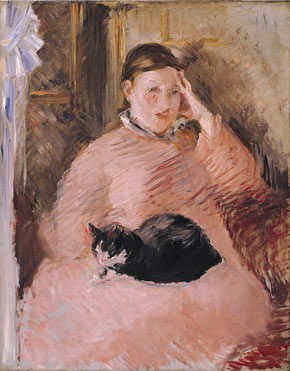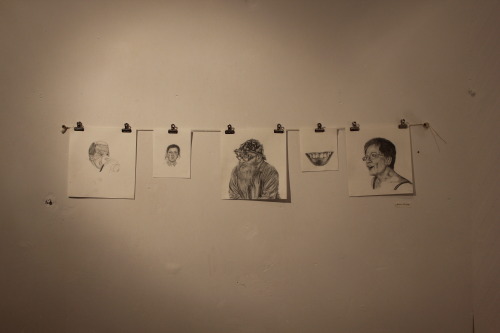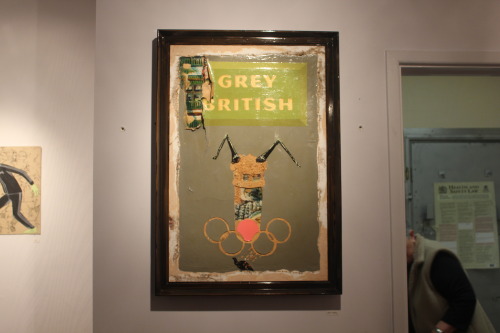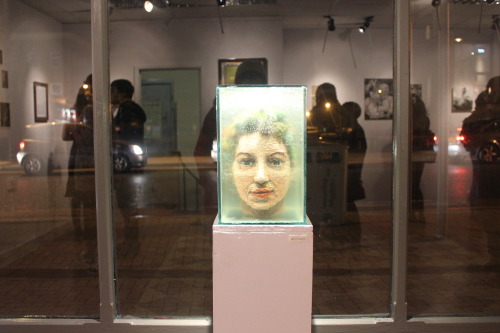I was lucky enough to get a space on the coach last week to London to see the Manet show at the RA. It was fairly last minute so, with no set agenda, I took a Galleries guide and just spent the day on a whim.
As the RA was very busy and my ticket was timed, I took a wander down Cork Street to see what was going on. First stop was
Flowers, where there was a survey of Claerwen James' portraiture, which was fresh to me and which I found to be quite captivating. Aesthetically, James' palette is very appealing to me while the flat, graphic delivery of the paint onto the surface really sings. They retain a painterly quality all the while, however, which is perhaps achieved by the use of oil on board. Conceptually, the paintings evoke a mysterious sense of stillness and unease, created by using photographs as a basis for the works. In the press release, the artist is said to believe that the photographs are "crucial to the painful, elegiac quality of the paintings."
 |
| Claerwen James, "Barefoot girl in yellow", 2006 |
Next I had a peek in
Redfearn Gallery a few doors down, where there was a mixed exhibition of painting, print and collage. Small scale works that caught my eye were by John Minton, Patrick Proctor and Keith Vaughan, while at the other end of the scale was an eye-catching drawn piece entitled "Head" [1965] by sculptor Elisabeth Frink.
The current exhibition at
Browse and Darby is of work by Patrick George, who deals mainly in landscapes. While his painting style is effective and precise, really I was impressed by the works on paper which displayed great levels of draughtsmanship and technical expertise. On display were studies of people, animals, boating scenes which were all of an extraordinary quality.
 |
| Patrick George, "Dining room chair" |
I was enticed inside
Marlborough Fine Art by the fascinating display in the window. Paula Rego was showing "Dame with the goat's foot and other stories", a series of recent works on paper that were based on the curious display: a disconcerting group of lifeless, life-size dolls, humanoids, animals and hybrids were arranged eerily in a group, like the cast of a bizarre pantomime. The resulting pastel-conte-charcoal works follow suit in their creepy, narrative style.
 |
| Paula Rego, "School for little witches", 2009 |
At last I made it inside the
Royal Academy, where "Manet: Portraying Life" was proving to be very popular. I made notes on several of the paintings, with particular reference to their technique and style over any other aspect. The paintings of his wife, Suzanne Leenhoff (Mme. Manet) were interesting because of their rapid and vital direction. It is suggested that their unfinished state indicates that they were not intended for public exhibition. Furthermore, "Woman with a cat" gives an indication of Manet's way of working; the rushed, 'sketchy' piece features long, zig-zag brushstrokes which suggest a kind of crosshatch technique to Manet's underpainting. There is a strong physicality to many of the works on display, the markmaking evokes a sense of intense creativity and it is easy to picture Manet as a fervent and passionate artist at work. In contrast; the more finished, official-looking paintings lack the life-force and immediacy of the aforementioned works. I appreciate the opportunity to see the artist's process; Manet is presented as a painter of enormous imagination and vivacity.
 |
| Edouard Manet, "Woman with a cat", 1880-2 |
After lunch I decided to head to the
National Portrait Gallery to have a look at the contemporary wing. I was glad to have gone as it was a great source of ideas for my own work. "Three Royal Court theatre directors" [2004] by Justin Mortimer was a pleasant surprise, as I had not expected to see his work there and have only seen it on paper. Up close the work is captivating and painterly, and of a high quality that I've come to expect from Mortimer. I also got a glimpse of Marlene Dumas' recent "Amy Blue" painting, which gained a lot of press when it was first shown. It seemed to me to be a rather elementary painting in it's style and the actual canvas was primed with a horrible white which, although deliberate, I couldn't help but dislike the aesthetic of it. There was a room dedicated to Humphrey Ocean's ongoing "A handbook of modern life" series, which I loved. Here he is creating a continuous journal of life experience and encounters with his contemporaries, something which I am currently aspiring to do in my work. Another work which struck me was Maggi Hambling's charcoal study of Stephen Fry [1993]; a highly accomplished and expressive piece which retains a loose, rhythmic effect.
 |
| Humphrey Ocean, "Felix", 2007 |
Finally I made a brief stop at the
ICA where Juergen Teller's "Woo!" exhibition was on. The large scale photographs of a nude Vivienne Westwood were surprising and mildly titilating to me, while his series of photographs "Irene im Wald" showed a more personal, reflective side to the unconventional photographer. One room was plastered with spreads from magazines that he'd created, featuring humourous, posed and naked photos of himself, supermodels, designers and celebrities. These were mostly amusing and pleasing to the eye, whereas the more formal photographs upstairs were captivating for their more human, inward-looking style. Altogether the show was light relief after a day of looking at paintings. I wonder why photography is, at times, easier to look at? I don't feel such a need to find meaning or criticism for a photograph in the same way that I do for a painting.
Overall, the day was unexpectedly informative to my practice, and I gained a good insight into the current practices of artists I hadn't expected to before.














